Potential Impacts of Soil Tillage System on Isoflavone Concentration of Soybean as Functional Food Ingredients
Abstract
:1. Introduction
2. Materials and Methods
2.1. Materials
2.2. Field Experimental Design and Crop Management at the Agricultural Research and Development Station Turda-Cluj, Romania
2.3. Yields and Isoflavone Contents of Soybean Grown during 2014–2016
2.4. Isoflavone Extraction and High-Performance Liquid Chromatography (HPLC) Analysis
2.5. Statistical Analyses
3. Results
3.1. Experimental Year 2014
3.2. Experimental Year 2015
3.3. Experimental Year 2016
3.4. Comparison of Soybean Yields and Isoflavone Concentrations for 2014–2016
4. Discussion
5. Conclusions
Author Contributions
Funding
Acknowledgments
Conflicts of Interest
Appendix A
| No. | Conventional Soil Tillage with and without Weed Controls | No. | Minimum Tillage with and without Weed Controls | No. | No-tillage with Weed and without Controls |
|---|---|---|---|---|---|
| 1 | sms1wct1 | 4 | sms2wct1 | 7 | sms3wct1 |
| 2 | sms1wct2 | 5 | sms2wct2 | 8 | sms3wct2 |
| 3 | sms1wct3 | 6 | sms2wct3 | 9 | sms3wct3 |
| Year Crop Yield (kg/ha) | |||
|---|---|---|---|
| Soil Systems | 2014 | 2015 | 2016 |
| sms1wct1 | 429 ± 11 aA | 496 ± 15 aB | 521 ± 19 aC |
| sms1wct2 | 2167 ± 183 bA | 2243 ± 198 bA | 3012 ± 111 bB |
| sms1wct3 | 2048 ± 176 bA | 2152 ± 189 bA | 2952 ± 96 bB |
| Average | 1548 ± 123 | 1630 ± 134 | 2161.91 ± 75 |
| sms2wct1 | 397 ± 7 aA | 492 ± 16 aB | 510 ± 18 aB |
| sms2wct2 | 2015 ± 189 bA | 2076 ± 177 bA | 2980 ± 89 bB |
| sms2wct3 | 1943 ± 163 bA | 1974 ± 170 bA | 2834 ± 73 bB |
| Average | 1451 ± 120 | 1514 ± 121 | 2108 ± 60 |
| sms3wct1 | 385 ± 7 aA | 488 ± 14 aB | 492 ± 17 aB |
| sms3wct2 | 1950 ± 175 bA | 1991 ± 168 bA | 2874 ± 78 bB |
| sms3wct3 | 1921 ± 180 bA | 1986 ± 171 bA | 2812 ± 118 bB |
| Average | 1418 ± 121 | 1488 ± 118 | 2059 ± 71 |
| Total Average | 1473 ± 12 | 1544 ± 14 | 2109 ± 9 |
| Year | 2014 | 2015 | 2016 |
|---|---|---|---|
| Total Isoflavones | Amounts (µg/g) | Amounts (µg/g) | Amounts (µg/g) |
| sms1wct1 | 6800 ± 510 aA | 7854 ± 405 bB | 8172 ± 319 bC |
| sms1wct2 | 7131 ± 528 bA | 7569 ± 449 aA | 8433 ± 260 cB |
| sms1wct3 | 6744 ± 644 aA | 7598 ± 361 aA | 8256 ± 238 bB |
| Average | 6892 ± 561 | 7674 ± 405 | 8287 ± 272 |
| sms2wct1 | 6843 ± 577 aA | 7857 ± 449 bB | 8575 ± 270 cC |
| sms2wct2 | 6960 ± 613 aA | 7677 ± 382 aB | 8097 ± 404 bB |
| sms2wct3 | 6696 ± 610 aA | 7653 ± 481 aB | 7701 ± 362 aB |
| Average | 6833 ± 600 | 7729 ± 437 | 8124 ± 345 |
| sms3wct1 | 7493 ± 601 cA | 8457 ± 490 cC | 8181 ± 297 bA |
| sms3wct2 | 7097 ± 492 bA | 8778 ± 428 dC | 7909 ± 313 aA |
| sms3wct3 | 6731 ± 484 aA | 8455 ± 430 cC | 7834 ± 297 aB |
| Average | 7107 ± 526 | 8563 ± 449 | 7901 ± 302 |
| Total average | 6944 ± 562 | 7989 ± 430 | 8129 ± 307 |
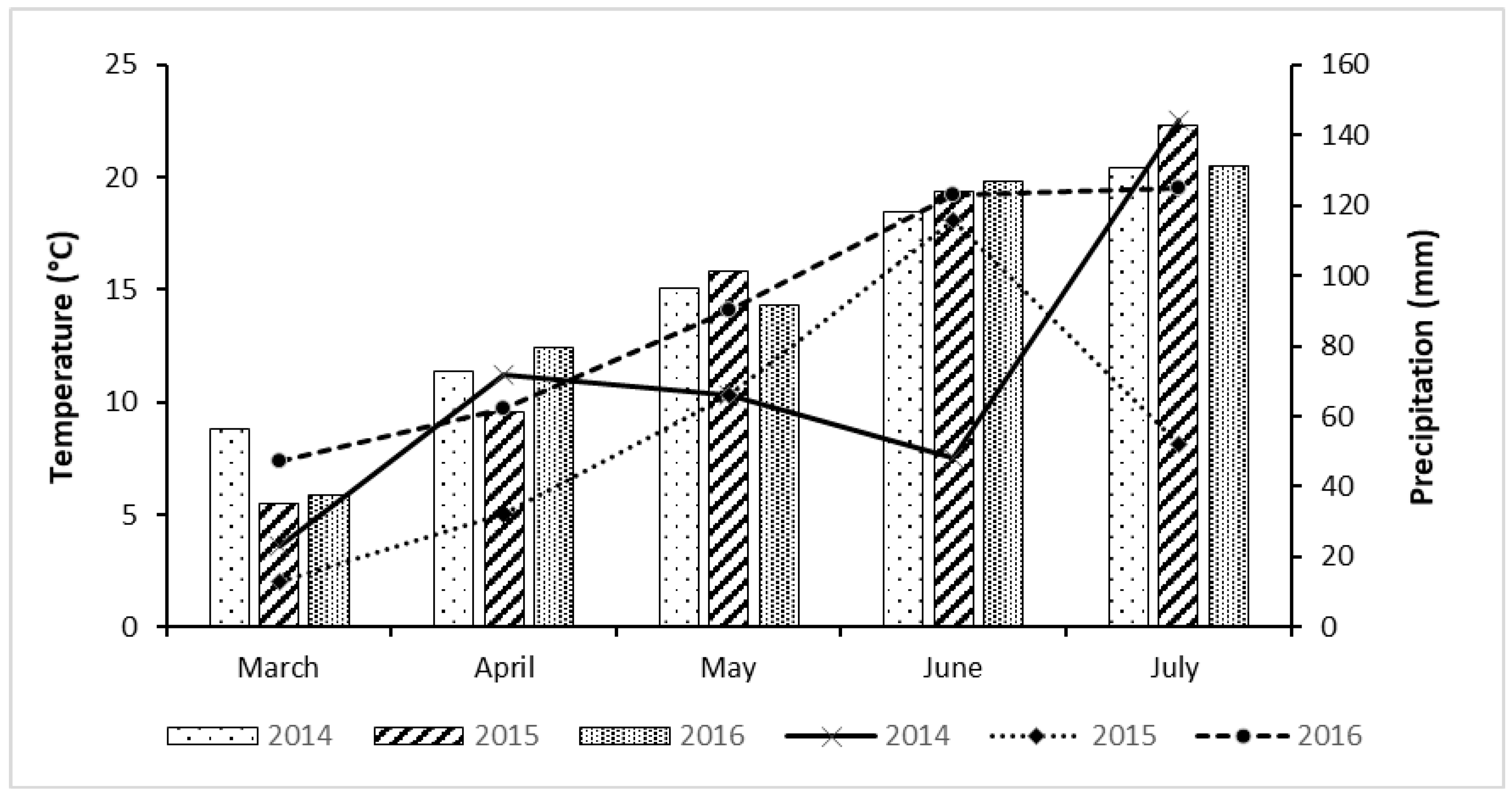
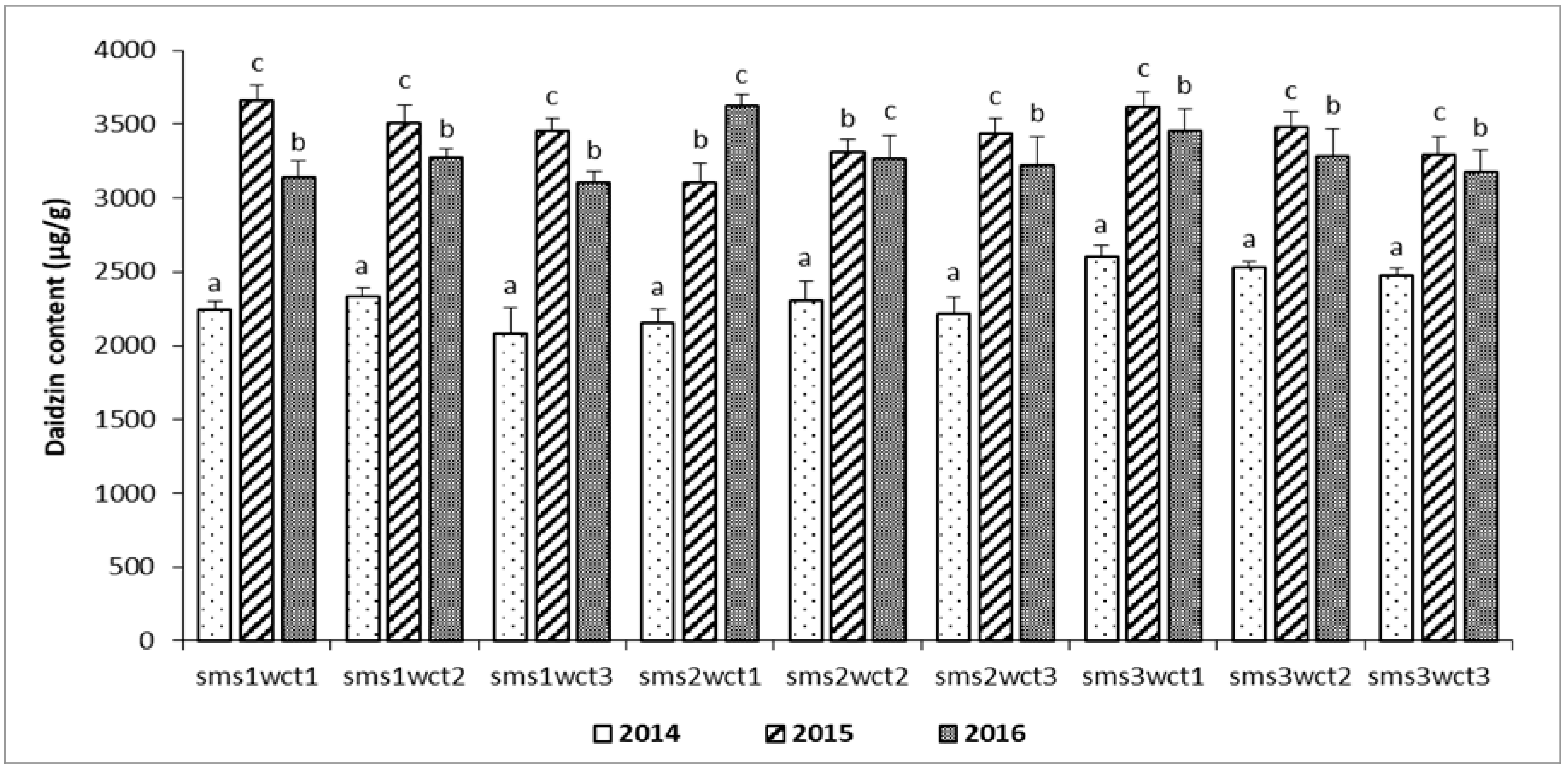
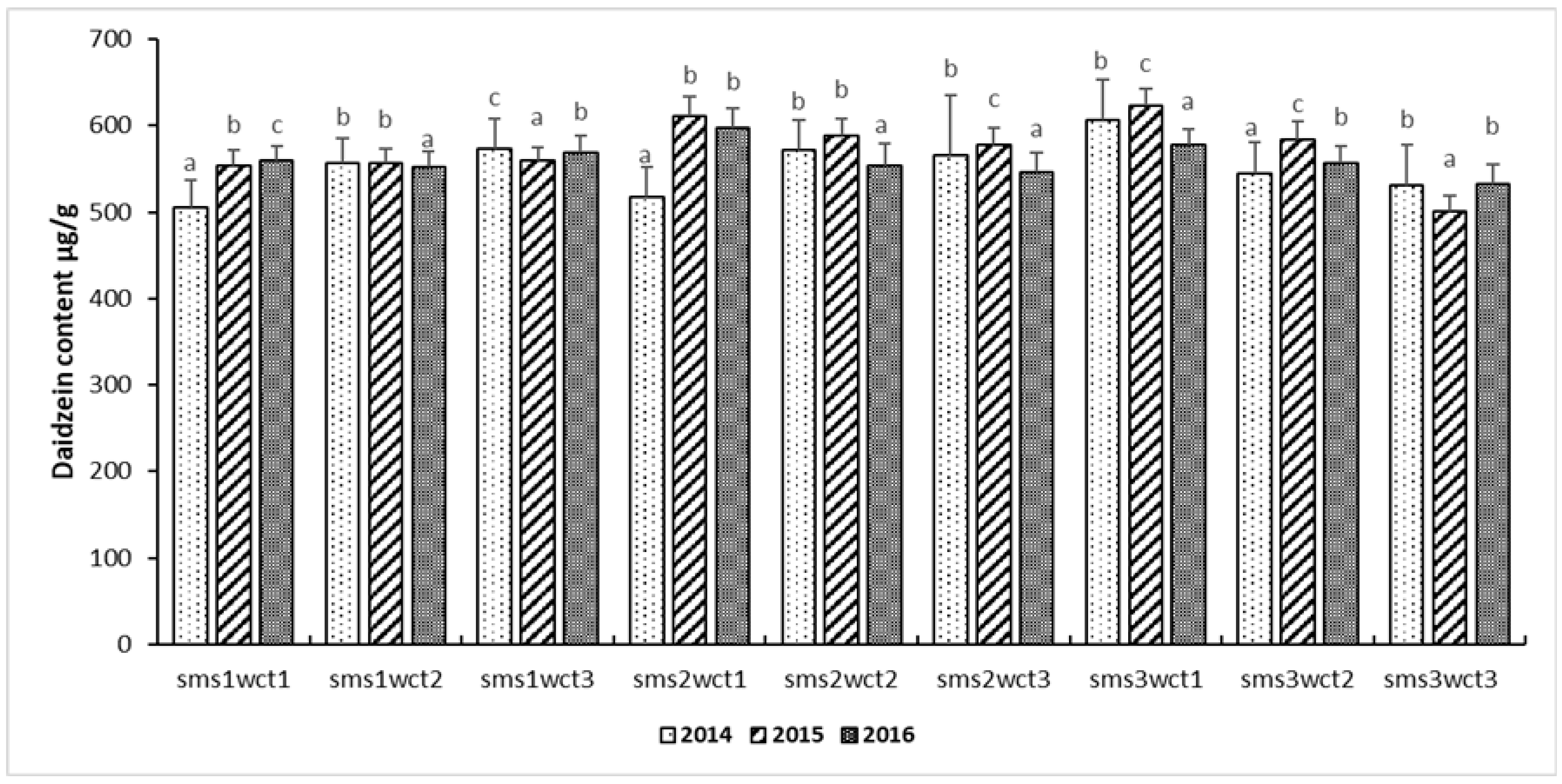
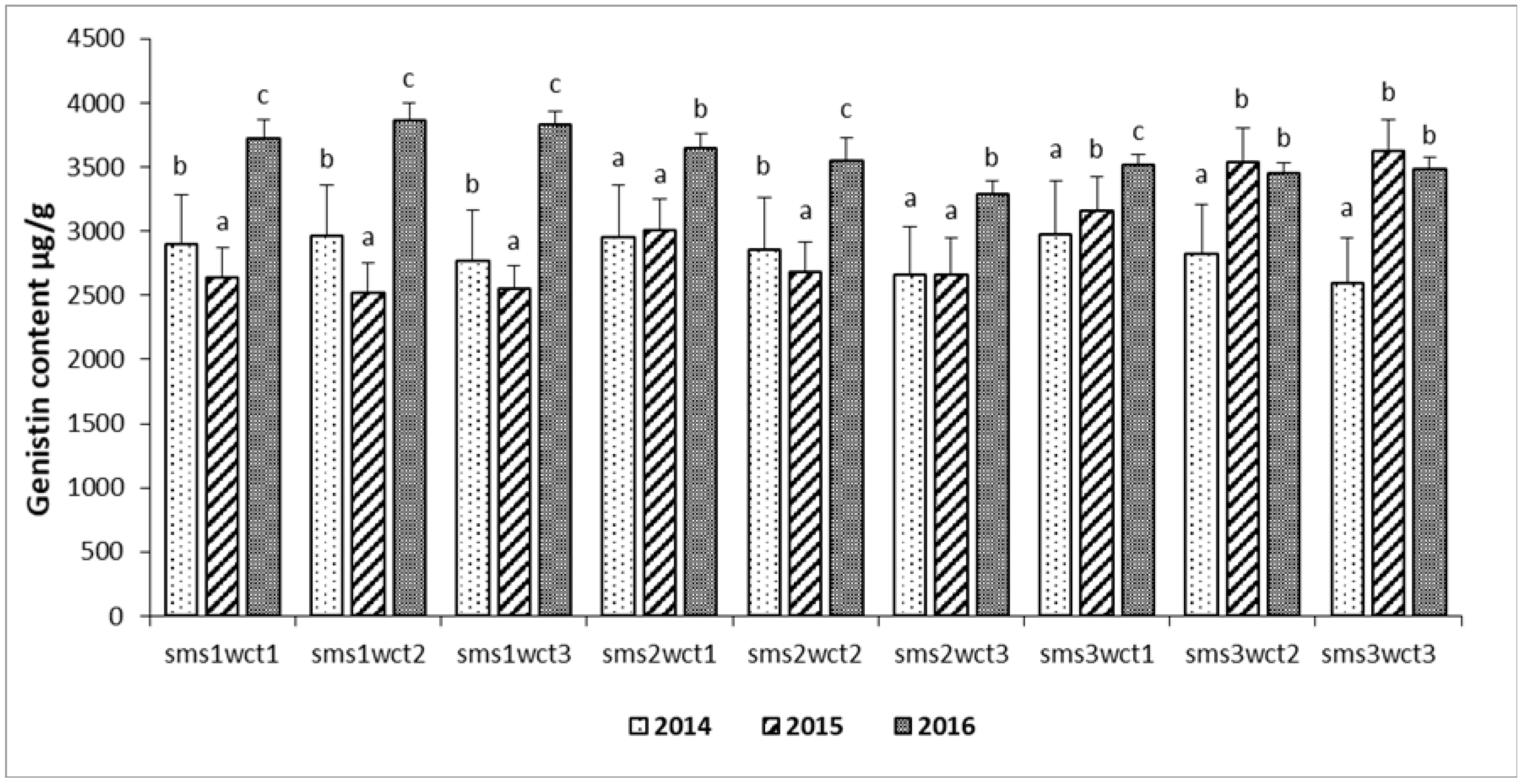
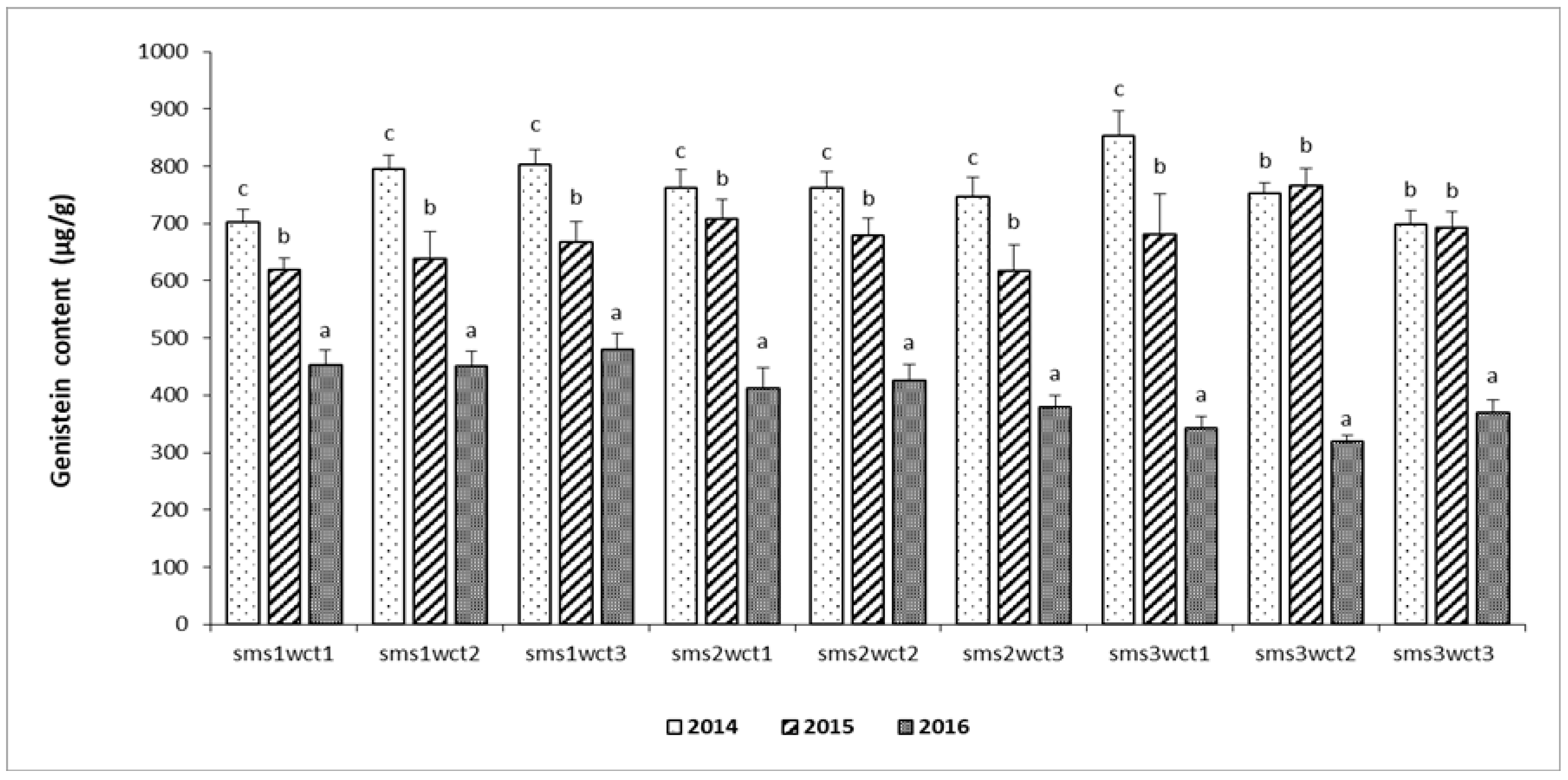
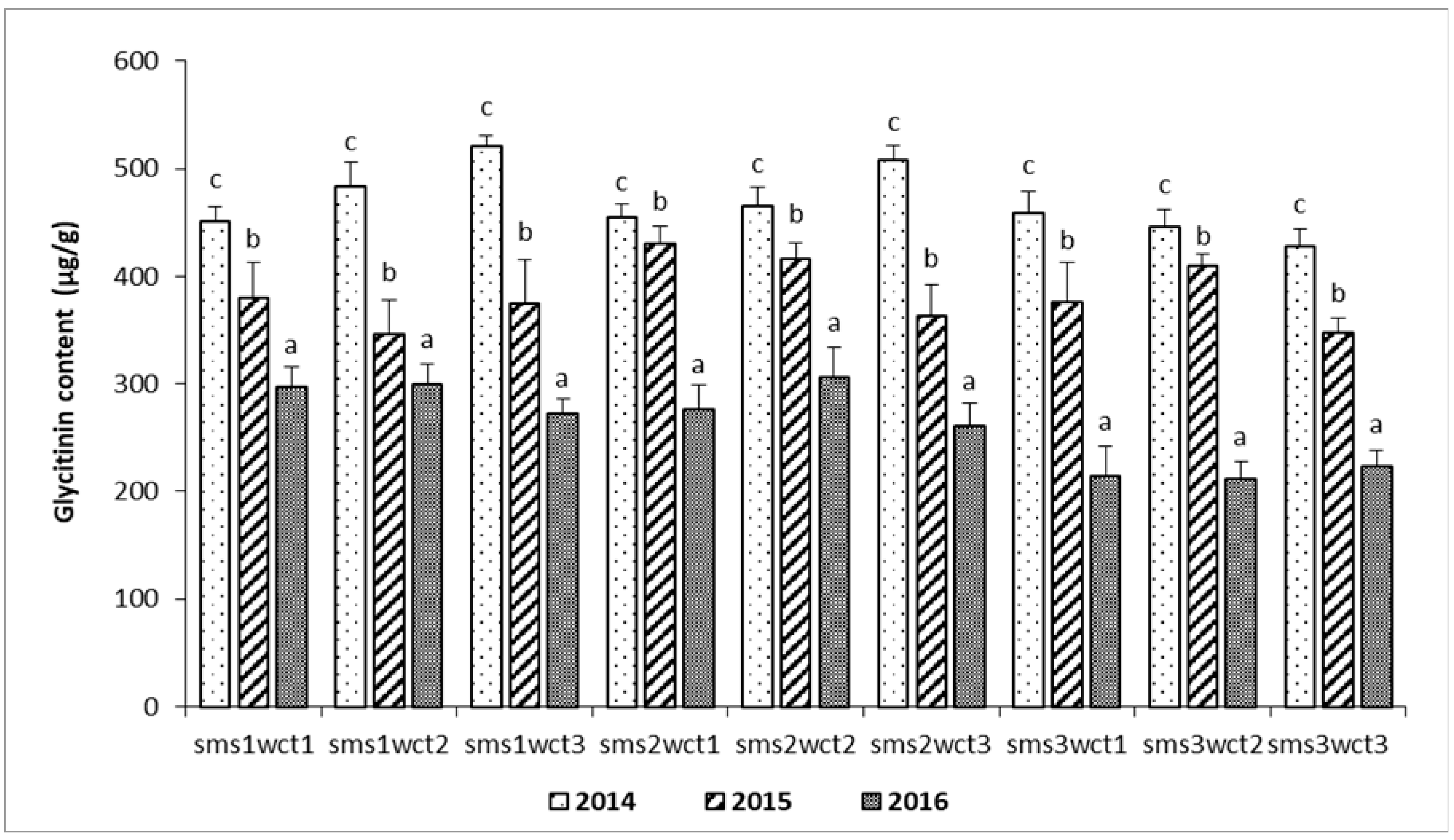
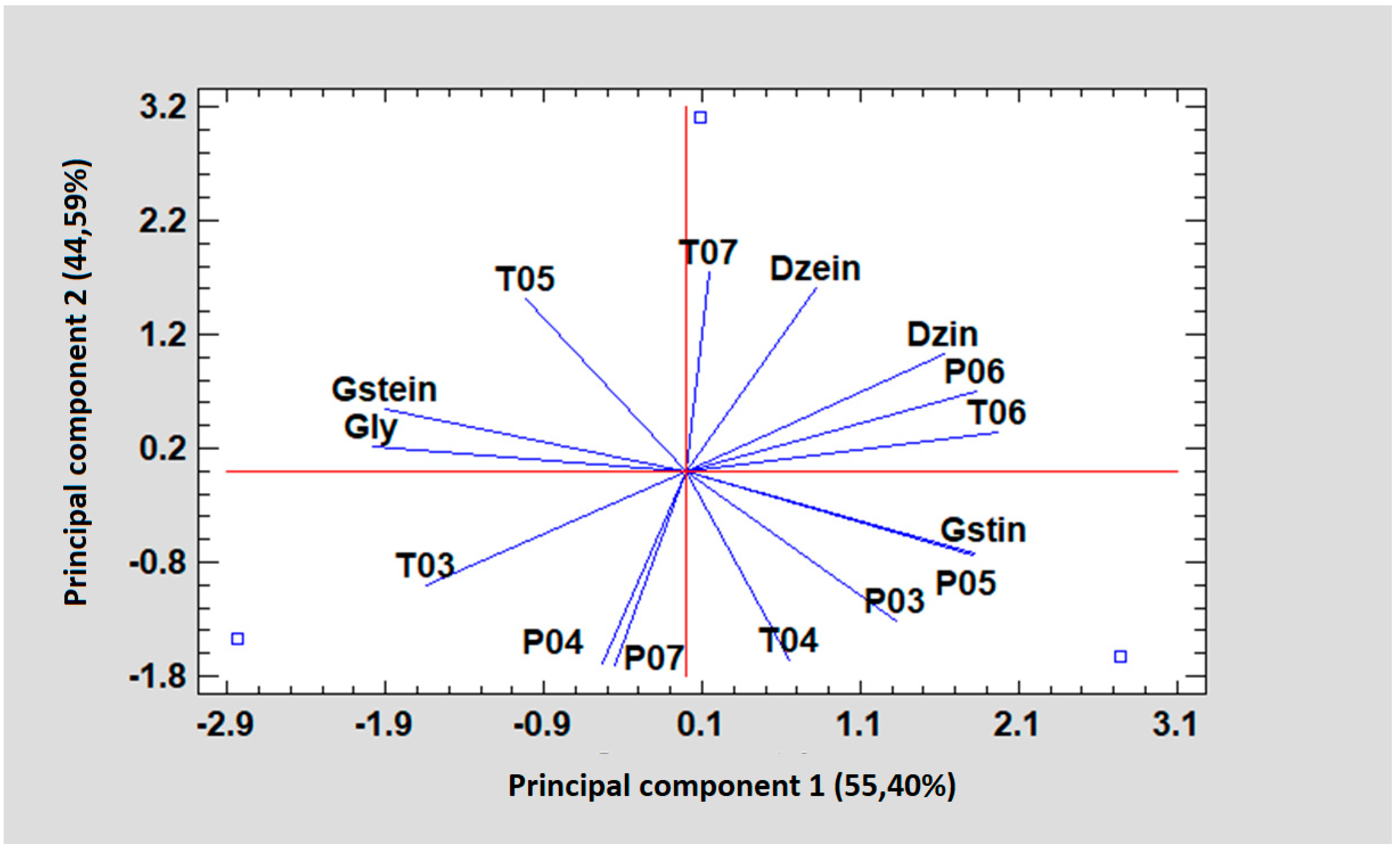
References
- Hu, C.; Wong, W.T.; Wu, R.; Lai, W.F. Biochemistry and use of soybean isoflavones in functional food development. Crit. Rev. Food Sci. Nutr. 2020, 60, 2098–2112. [Google Scholar] [CrossRef]
- Pawar, V.S.; Patil, B.M.; Syed, Z.; Salve, R.V. Soybean: A novel food grain for human health. Int. J. Chem. Stud. 2018, 6, 1894–1898. [Google Scholar]
- Kudou, S.; Fleury, Y.; Welti, D.; Magnolato, D.; Uchida, T.; Kitamura, K.; Okubo, K. Malonyl isoflavone glycosides in soybeans seeds (Glycine max (L.) Merrill). Agric. Biol. Chem. 1991, 55, 2227–2233. [Google Scholar] [CrossRef] [Green Version]
- Wang, H.; Murphy, P.A. Isoflavone Content in Commercial Soybean Foods. J. Agric. Food Chem. 1994, 42, 1666–1673. [Google Scholar] [CrossRef]
- Lee, J.H.; Renita, M.; Fioritto, R.J.; Martin, S.K.; Schwartz, S.J.; Vodovotz, Y. Isoflavone Characterization and Antioxidant Activity of Ohio Soybeans. J. Agric. Food Chem. 2004, 52, 2647–2651. [Google Scholar] [CrossRef]
- Coward, L.; Barnes, N.C.; Setchell, K.D.R.; Barnes, S. Genistein and daidzein, and their β-glycoside conjugates: Anti-tumor isoflavones in soybean foods from American and Asian diets. J. Agric. Food Chem. 1993, 41, 1961–1967. [Google Scholar] [CrossRef]
- Messina, M.; Barnes, S. The role of soy products in reducing risk of cancer. J. Natl. Cancer Inst. 1991, 83, 541–546. [Google Scholar] [CrossRef] [Green Version]
- Banz, W.; Williams, M.; Lightfoot, D.; Winters, T. Effects of Soy Protein and Soy Phytoestrogens on Symptoms Associated with Cardiovascular Disease in Rats. J. Med. Food 1999, 2, 271–273. [Google Scholar] [CrossRef]
- Kanchana, P.M.; Lakshmi, S.; Raja, K.D. A Review of Glycine Max (L.) Merr. (Sybean). World J. Pharm. Pharm. Sci. 2015, 5, 356–371. [Google Scholar]
- Boerema, A.; Peeters, A.; Swolfs, S.; Vandevenne, F.; Jacobs, S.; Staes, J.; Meire, P. Soybean trade: Balancing environmental and socio-economic impacts of an intercontinental market. PLoS ONE 2016, 11, e0155222. [Google Scholar] [CrossRef] [PubMed]
- Tsukamoto, C.; Shimada, S.; Igita, K.; Kudou, S.; Kokubun, M.; Okubo, K.; Kitamura, K. Factors affecting isoflavone content in soybean seeds: Changes in isoflavones, saponins composition of fatty acids at different temperatures during the seeds development. J. Agric. Food Chem. 1995, 43, 1184–1192. [Google Scholar] [CrossRef]
- Meksem, K.; Njiti, V.N.; Banz, W.J.; Iqbal, M.J.; Kassem, M.M.; Hyten, D.L.; Yuang, J.; Winters, T.A.; Lightfoot, D.A. Genomic regions that underlie soybean seed isoflavone content. BioMed Res. Int. 2001, 1, 38–44. [Google Scholar] [CrossRef] [PubMed] [Green Version]
- Aussenac, T.; Lacombe, S.; Daydé, J. Quantification of isoflavones by capillary zone electrophoresis in soybean seeds: Effects of variety and environment. Am. J. Clin. Nutr. 1999, 68, 1480S–1485S. [Google Scholar] [CrossRef] [PubMed]
- Sakthivelu, G.M.K.; Akitha-Devi, P.; Giridhar, T.; Rajasekharan, G.A.; Ravishankar, T.N.; Kosturkova, G. Drought-induced alterations in growth, osmotic potential and in-vitro regeneration of soybean cultivars. Gen. Appl. Plant. Physiol. 2008, 34, 103–112. [Google Scholar]
- Carrão-Panizzi, M.C.; Berhow, M.; Mandarino, J.M.G.; Oliveira, M.C.N.D. Environmental and genetic variation of isoflavone content of soybean seeds grown in Brazil. Pesqui. Agropecu. Bras. 2009, 44, 1444–1451. [Google Scholar] [CrossRef] [Green Version]
- Caldwell, C.R.; Britz, S.J.; Mirecki, R.M. Effect of Temperature, Elevated Carbon Dioxide, and Drought during Seed Development on the Isoflavone Content of Dwarf Soybean [Glycine max (L.) Merrill] Grown in Controlled Environments. J. Agric. Food Chem. 2005, 53, 1125–1129. [Google Scholar] [CrossRef]
- Yin, X.; Vyn, T.J. Relationships of Isoflavone, Oil, and Protein in Seed with Yield of Soybean. Agronom. J. 1997, 97, 1314–1321. [Google Scholar] [CrossRef] [Green Version]
- Barion, G.; Hewidy, M.; Mosca, G.; Vamerali, T. Intraspecific variability for soybean cotyledon isoflavones in different cropping and soil conditions. Eur. J. Agr. 2010, 33, 63–73. [Google Scholar] [CrossRef]
- Dima, D.C. Soybean Crop in Romania, Bulgaria and the Republic of Moldova: Current Situation and Perspectives. Agric. Agric. Sci. Procedia 2015, 6, 3–8. [Google Scholar] [CrossRef]
- Moraru, P.I.; Rusu, T.; Guș, P.; Bogdan, I.; Pop, A.I. The role of minimum tillage in protecting environmental resources of the Transylvanian Plain, Romania. Rom. Agric. Res. 2015, 32, 127–135. [Google Scholar]
- Rusu, T. Energy efficiency and soil conservation in conventional, minimum tillage and no-tillage. Int. Soil Water Conserv. Res. 2014, 2, 42–49. [Google Scholar] [CrossRef] [Green Version]
- Rusu, T.; Bogdan, I.; Moraru, P.I.; Pop, A.I.; Duda, B.M.; Coste, C. Research results on conservative tillage systems in the last 50 years at USAMV Cluj-Napoca. ProEnvironment 2015, 8, 105–111. [Google Scholar]
- Mureşanu, E.; Mărginean, R.; Negru, S. Early soybean cultivar-Felix. Analele I.N.C.D.A. Fundulea. 2010, LXXVIII, 55–62. [Google Scholar]
- Muntean, L.S.; Cernea, S.; Morar, G.; Duda, M.M.; Virban, D.I.; Muntean, S.; Moldovean, C. Fitotehnie, III. Ed.; Risoprint: Cluj-Napoca, Romania, 2014. [Google Scholar]
- Cheţan, C.; Rusu, T.; Cheţan, F.; Şimon, A. Research Regarding the Influence of the Weed Control Treatments on Production and Qualitative Indicators of the Soybean Cultivated in Minimum Tillage System. Bull. Univ. Agric. Sci. Vet. Med. Cluj-Napoca Agric. 2016, 73, 170–175. [Google Scholar]
- Eldridge, A.C. High-performance liquid chromatography separation of soybean isoflavones and their glucosides. J. Chromatogr. 1982, 234, 494. [Google Scholar] [CrossRef]
- Britz, S.J.; Schomburg, C.J.; Kenworthy, W.J. Isoflavones in seeds of field-grown soybean: Variation among genetic lines and environmental effects. J. Am. Oil Chem. Soc. 2011, 88, 827–832. [Google Scholar] [CrossRef]
- Lozovaya, V.V.; Lygin, A.V.; Ulanov, A.V.; Nelson, R.L.; Dayde, J.; Widholm, J.M. Effect of Temperature and Soil Moisture Status during Seed Development on Soybean Seed Isoflavone Concentration and Composition. Crop. Sci. 2005, 45, 1934–1940. [Google Scholar] [CrossRef] [Green Version]
- Murphy, P.A.; Barua, K.; Hauck, C.C. Solvent extraction selection in the determination of isoflavones in soy foods. J. Chromatogr. B 2002, 777, 129–138. [Google Scholar] [CrossRef]
- Xu, B.; Chang, S.K.C. Characterization of phenolic substances and antioxidant properties of food soybeans grown in North Dakota-Minnesota region. J. Agric. Food Chem. 2008, 56, 5102–9113. [Google Scholar] [CrossRef]
- Teekachunhatean, S.; Hanprasertpong, N.; Teekachunhatean, T. Factors Affecting Isoflavone Content in Soybean Seeds Grown in Thailand. Int. J. Agron. 2013, 2013, 163573. [Google Scholar] [CrossRef] [Green Version]
- Lee, S.J.; Yan, W.; Ahn, J.K.; Chung, I.M. Effects of year, site, genotype and their interactions on various soybean isoflavones. Field Crops Res. 2003, 81, 2–3. [Google Scholar] [CrossRef]
- Chennupati, P.; Seguin, P.; Liu, W. Effects of high temperature stress at different development stages on soybean isoflavone and tocopherol concentrations. J. Agric. Food Chem. 2011, 59, 13081–13088. [Google Scholar] [CrossRef] [PubMed]
- Gutierrez-Gonzalez, J.J.; Wu, X.; Gillman, J.D.; Lee, J.D.; Zhong, R.; Yu, O.; Shannon, G.; Ellersieck, M.; Nguyen, H.T.; David, A. Intricate environment-modulated genetic networks control isoflavone accumulation in soybean seeds. BMC Plant. Biol. 2010, 10, 105. [Google Scholar] [CrossRef] [PubMed] [Green Version]
- Carrera, C.S.; Dardanelli, J.L.; Soldini, D.O. Genotypic and environmental variation in seed nutraceutical and industrial composition of non-transgenic soybean (Glycine max) genotypes. Crop. Pasture Sci. 2014, 65, 1311–1322. [Google Scholar] [CrossRef]
© 2020 by the authors. Licensee MDPI, Basel, Switzerland. This article is an open access article distributed under the terms and conditions of the Creative Commons Attribution (CC BY) license (http://creativecommons.org/licenses/by/4.0/).
Share and Cite
Mureșan, L.; Clapa, D.; Borsai, O.; Rusu, T.; Wang, T.T.Y.; Park, J.B. Potential Impacts of Soil Tillage System on Isoflavone Concentration of Soybean as Functional Food Ingredients. Land 2020, 9, 386. https://doi.org/10.3390/land9100386
Mureșan L, Clapa D, Borsai O, Rusu T, Wang TTY, Park JB. Potential Impacts of Soil Tillage System on Isoflavone Concentration of Soybean as Functional Food Ingredients. Land. 2020; 9(10):386. https://doi.org/10.3390/land9100386
Chicago/Turabian StyleMureșan, Liliana, Doina Clapa, Orsolya Borsai, Teodor Rusu, Thomas T. Y. Wang, and Jae B. Park. 2020. "Potential Impacts of Soil Tillage System on Isoflavone Concentration of Soybean as Functional Food Ingredients" Land 9, no. 10: 386. https://doi.org/10.3390/land9100386






